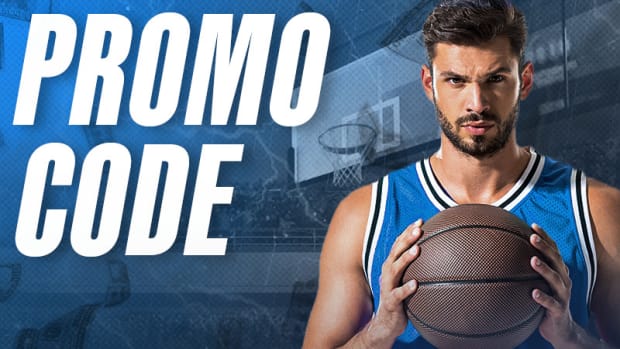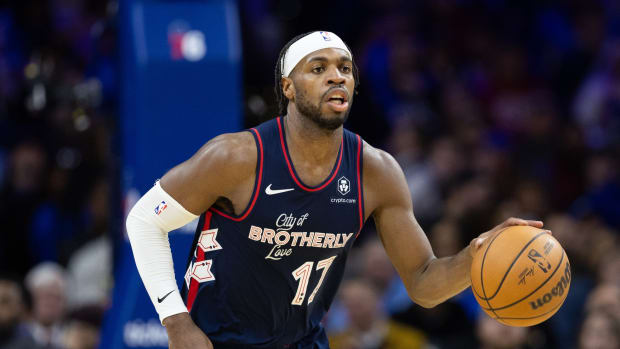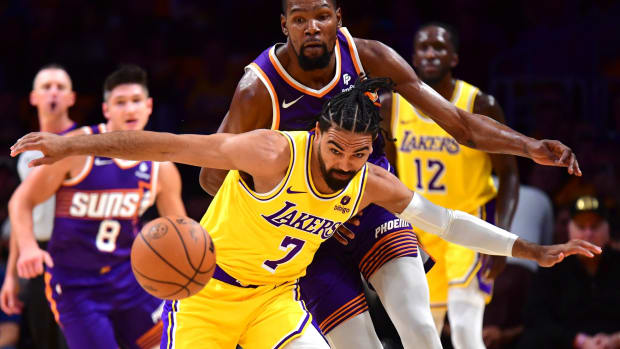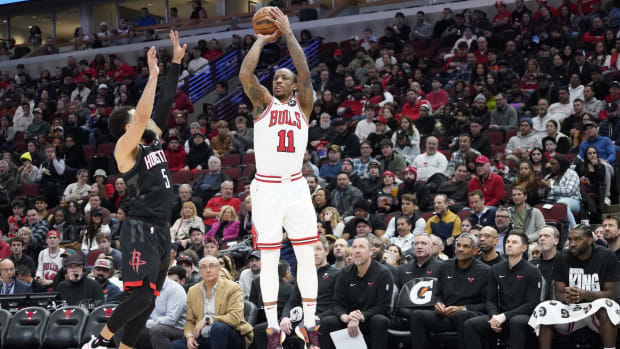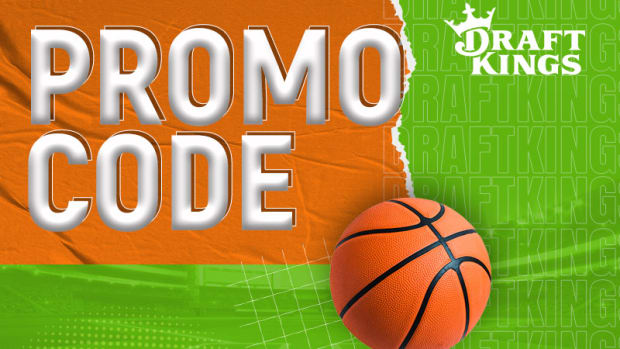
The Fundamentals: Can any East team keep Heat from NBA Finals?
Paul George (left) and the Pacers have the defense to at least slow down LeBron James and the Heat. (Ron Hoskins/NBAE via Getty Images)
By Rob Mahoney
This season has operated under the assumption that the Eastern Conference is Miami's to lose, and though the Heat's interest has waxed and waned through their first 38 games, there's no reason to abandon that premise yet. They've experienced some setbacks, but a motivational downswing is not unusual for a highly talented team in a title-defending regular season. The prize has already been won, and though the Heat are clearly interested in a repeat, they're certainly not above biding their time -- in the spirit of title teams past -- until the framework of a seven-game series instills the basis for effort and order.
For now, the Heat are viewed as a team lacking in defensive focus and rebounding efficacy that nonetheless boasts the best basketball player in the world and the overall profile of a championship contender. They may have entered Monday's play leading the second-seeded Knicks by only one game, but the Heat ultimately have the least to prove; they've shown how overwhelming they can be when all of the core pieces are in the lineup and executing with an end goal in mind, while their East rivals are still out to prove that they can keep up with Miami's extra gear.
So let's check in with those other teams in hopes of understanding which ones might eventually have the best chance of testing Miami's resolve. As good as the Heat are (and, more important, will be), they're hardly unbeatable. But is any team in the middle-heavy East really up to the task of dethroning the champs? As I see it, there are only three even semi-realistic possibilities:
INDIANA PACERS (25-16, third in the East through Sunday)
It's not surprising that Indiana leads the NBA in points allowed per possession. Frank Vogel has not only proved to be a fantastic motivational coach but he's also done a great job of tailoring his defensive schemes to his personnel and setting realistic strategies for each player. For instance, Roy Hibbert and David West occupy some of the same defensive space, but they wind up doing fundamentally different things in coverage -- as they can and should.
But on a more counterintuitive note, Indiana has one of the most balanced starting lineups in the NBA despite an offense that on average is one of the league's worst. Only the Wizards, who played their first 33 games without John Wall, have scored fewer points per possession than the Pacers (Indiana sits at 98.4), and those two are the only teams to rank in the bottom five in both effective field-goal percentage (which factors in the added value of three-pointers) and turnover rate. Interestingly enough, neither of those metrics pertain to Indiana's starting five -- a group that registers far better offensive production across the board and scores at a rate of 106.6 points per 100 possessions. That mark would rank sixth among NBA teams despite the season-long absence of Danny Granger and the season-long slump of Roy Hibbert -- and should help put the horrendous performance of the Pacers' bench into context. Reserves D.J. Augustin and Gerald Green have simply been that bad. Granger's return (and thus Lance Stephenson's move back to the bench) will make the starting lineup more dynamic and help bridge some of the hybrid starter-sub lineups with his scoring, but it won't cure all ills.
That said, the playoffs are a different beast entirely. Once there, Vogel would have the ability to crank up the minutes on each of his significant players (save Hibbert) while curtailing the empty minutes of Augustin and Green, among others. Paul George, in particular, could be in line for a LeBron-like average of more than 40 minutes per playoff game, especially if Indiana hangs around long enough to meet Miami in the conference finals. In the context of that hypothetical series, George would prove indispensable. Not only is he the best option to defend either James or Dwyane Wade, but the rest of his skill set (elite rebounding, sharp shooting from the perimeter, speed and handle in transition) aligns perfectly with Miami's points of weakness. That alone would hardly be enough for the Pacers against the Heat, but it's a start -- and one that will be aided by Indiana's first-rate defensive execution.
No team can hope to really stop James or the Heat overall, but the Pacers do a fantastic job of taking away shots at the rim and the three-point line. The Pacers are particularly proficient in limiting corner three-point attempts. That may seem like such a small sliver of offensive performance, but the corners are an invaluable pressure release for the league's most efficient offenses and a key source of scoring for players such as Ray Allen and Shane Battier. James will get his, Wade will likely go off at some point and Chris Bosh may put up some points, too. But teams like Indiana can create leverage in a game and in a series by eliminating the scoring impact of the Heat's role players.
Take that specific strength, the flexibility of the Pacers' defensive rotations overall and Vogel's choice to keep Hibbert stationed around the rim pretty much at all times, and Indiana's defense is easily the most formidable among potential Miami opponents. But the cold truth is that it's still likely not enough, if only because Indiana's starters will have to rest at some point and the Heat's frenetic potency can render even the best defenses (and balanced offenses) irrelevant.
Jason Kidd (right) and the new-look Knicks are 2-0 against the Heat this season. (Nick Laham/Getty Images)
NEW YORK KNICKS (25-13, second in the East)
The shooting has cooled, but these Knicks -- who have soundly defeated Miami twice and are one of two teams to win at San Antonio -- still register as a pleasant surprise. Carmelo Anthonyis playing the best basketball of his career. Tyson Chandler hasn't always been on top of his defensive game, but he is scoring more than ever before and still makes up for so many mistakes in New York's coverage. Jason Kidd and Raymond Felton have each been born again in the Knicks' offense after crummy seasons in Dallas and Portland, respectively. J.R. Smith blisters opponents regularly and burns the Knicks less frequently than expected.
We could go on and on, as this team has benefited from upturn after upturn despite a roster that initially seemed too old and too limited. Altogether, that's yielded the NBA's second-best offense and a league-average defense -- which, oddly enough, is an inversion of what was expected this season, given their very different rankings (17th in points per possession, fifth in points allowed per possession) in 2011-12. That could signal one of two things:
• The nature of the Knicks' play has fundamentally changed.
• This team has two disparate means of success and the potential to meld them.
I lean toward the former. On offense, the changes are easy enough to observe. Anthony is playing differently, but more important, the Knicks on the whole are playing in a way that inflates the value of certain role guys. Players such as Felton, Smith, Kidd, Chandler, forward Steve Novak and point guard Pablo Prigioni are only asked to do what they do best, which pumps up their efficiency while leaving plenty of room for Anthony (and perhaps Amar'e Stoudemire, eventually) to provide bulk scoring.
On the defensive end, however, it seems as though coach Mike Woodson's Knicks have made a few too many compromises to replicate last season's success. Chandler may still register a Defensive Player of the Year-caliber impact, but blow-bys are far more prevalent than before and playing Anthony at power forward requires him to help in ways he isn't comfortable or capable. There isn't a single player or factor degrading the Knicks' D that isn't manageable on its own, but add all of those elements together and a league-average ranking (or worse) seems somewhat unavoidable.
The wild card there is hyper-athletic ball hound/emerging cult hero Iman Shumpert, who should figure prominently into the Knicks' plans now that he's recovered from an ACL tear suffered in last season's playoffs. Shumpert is clearly New York's best perimeter defender, but that alone can't shore up a defense with so many other limitations. Perimeter defenders are generally locked into a fairly specific (and in a way, limited) zone of defensive viability; Shumpert will be able to deter one scorer, but he isn't versatile enough to make an across-the-floor impact in the same way that, say, Chandler is. Plus, many of the best teams in the East will be keeping an eye on Shumpert's three-point shooting, considering his subpar mark a season ago (30.6 percent) and the Knicks' reliance on perimeter shooting. If that becomes an issue, Shumpert could also provide enough of a drag on New York's offense to counteract some of the good that he does on defense.
All of which is to say that New York doesn't seem to have the balance necessary to overcome Miami. The Knicks would win some games in a playoff series, but they would be facing a team with an equally prolific offense and a potentially asphyxiating defense. Some interesting matchups would come into play, but with James and Battier taking turns against Anthony on a Miami team with postseason discipline and the ability to outgun the Knicks, where exactly is there room for a potential upset?
The health of Derrick Rose will ultimately determine the Bulls' postseason fate. (Mike Ehrmann/Getty Images)
CHICAGO BULLS (23-16, fifth in the East)
The world of sports is powered by notions of "if," but no NBA team bears the same weight of Chicago's conditionality. The Bulls have the vague potential to be a legitimate contender, but if and only if: Derrick Rose returns this season in time to get up to speed; he retains the explosion off the dribble that made him so effective before his ACL tear; and coach Tom Thibodeau is able to structure a real offense around Rose midseason.
That's a lot to bank on, but nonetheless leaves contention as an open possibility for one of the league's elite defenses. Roster turnover be damned, Thibodeau again has the Bulls winning games with pitch-perfect defensive rotations and conservative shot selection, which ultimately sets the stage rather perfectly for a healthy Rose to complete the picture. When in good health and at full strength, the Bulls would be at the forefront of this conversation. But Rose's absence has made this season a difficult one to gauge and predict, as there's simply no way of knowing what he might be capable of contributing in either the short or long term.
That makes it hard to make any kind of case for Chicago's offense, but it at least raises the chance of sufficient improvement. That means the Bulls can't be ruled out -- which puts them a step above the next group of teams. There's very good reason to believe that Boston's offense won't be up to snuff. There's still plenty of reason to doubt Brooklyn's defense. But Chicago is elite on one end of the court with a shot at making things work on the other end -- a combination that at least makes it a plausible entry into the kind-of-contender conversation.
It also doesn't hurt that the Bulls rank seventh in offensive rebounding rate (a facet of the game that boosts efficiency without interfering in Rose's operations) and a respectable 11th in free-throw rate (a standing that will only improve with Rose creating disarray for opponents and drawing contact on his drives). Chicago could use more shooting, but otherwise the only void is an elite shot creator. Whether Rose can fill that role immediately is anyone's guess, especially considering how many players in the Bulls' rotation have never (or have only rarely) played with him. But the possibility of a deep playoff run -- all predicated on those many "ifs" -- lingers, with a contending core so viable that it can't be ignored.
GO FIGURE
• One popular explanation for why the Trail Blazers have lost five consecutive games: the playing time of their starters, who are getting some serious burn of late even relative to their high minutes averages this season. In the last eight games, four Blazers rank in the NBA's top seven in minutes per game, with Nicolas Batum logging the most minutes in the league. It's possible that the in-game wear has become an issue at times, but the far bigger issue is that coach Terry Stotts -- who doesn't have a single reliable contributor on his bench -- is essentially forced to play his starters heavy minutes in the first place.
• Stoudemire has never been a particularly successful rebounder, but his performance through his first eight games and 166 minutes this year has registered as a new low. Stoudemire has grabbed 14.4 percent of available rebounds while on the floor in his career -- a mark that won't doom a team but hardly helps. According to Basketball-Reference, this season Stoudemire has nabbed a tragic 8.7 percent of possible boards, which is worse than every player identified as a center who has averaged 10 minutes per game this season. This is a tiny sample size, but a statistical curiosity worth monitoring.
• It's still strange to me that the Nuggets rank last in free-throw percentage at 68.1, and even stranger that their struggles stem from players across the board having career-worst (or near-worst) seasons at the line. Some (point guard Ty Lawson) have gone from solid to shaky, others (swingman Andre Iguodala) from shaky to flat-out bad and a select group (power forward Kenneth Faried) from bad to worse.
NOTES FROM AROUND THE ASSOCIATION
Jason Terry's minutes are way down since Avery Bradley's return. (Jared Wickerham/Getty Images)
1. Jason Terry's dwindling minutes
It was a given that Avery Bradley's comeback would force Boston coach Doc Rivers to redistribute minutes among his guards, and so far no player has forfeited a bigger slice of his role than Terry. The former Sixth Man Award winner averaged 33.3 minutes over a 20-game stretch in the middle of the season, but since then -- beginning immediately upon Bradley's return -- he has logged just 22.3 minutes, including only 19.4 minutes in the last five games.
This kind of "demotion" (I use that term very loosely) is entirely justifiable. Terry hasn't lived up to his offensive billing. The Celtics have benefited from Terry's ability to space the floor and execute some basic pick-and-rolls, but they were banking on more dynamic offensive contributions to validate a big-minute role as a combo guard off the bench. Nothing has really worked out as planned in Boston yet, and Terry's play is no different.
2. LeBron James, getting political
LeBron may not have committed to public neutrality as obsessively as Michael Jordan did, but throughout his career he has largely sidestepped the biggest of potential political questions and abstained from commenting on any bigger-than-basketball issues that happen to come his way in a media scrum. That's perfectly reasonable; no pro athlete should feel obligated to be a spokesman, and there is and was no reason to criticize the best player in basketball for simply refusing to be partisan.
But it was notable that when an NBA-specific matter cropped up that was certainly worthy of commentary, James made sure his voice was heard. After news began spreading that the Maloof family had reached a tentative agreement to sell the Kings based on a franchise valuation of $525 million, James piped up on Twitter:
https://twitter.com/KingJames/status/293219795552321536
https://twitter.com/KingJames/status/293220979499474944
Nothing groundbreaking, but an important voice in a league where the most prominent union officials are on the brink of retirement or the fringes of the NBA. If James were to play a more vocal role for the NBA players in the future, it could create an interesting league-union dynamic, to say the least.
3. Kosta Koufos, making it happen
Even on the superstar-less Nuggets, Koufos is a complete afterthought. The 23-year-old 7-footer cuts in to finish scrambled possessions. He grabs rebound after rebound, but does so far less spectacularly than Faried. His game is built on effort without any of the classic emblems of a hustle game, making him aesthetically bland but altogether helpful. The bottom line: Koufos (8.1 points and 6.5 rebounds in 23 minutes per game) has turned into a pretty solid player for Denver, if only in a role that holds very little pressure. A team would be in a bad spot if it had to actively rely on Koufos, but he's done some good work on the margins for one of the hottest teams in the NBA.
The Wizards are 3-2 since point guard John Wall (right) returned. (Garrett W. Ellwood/NBAE via Getty Images)
4. What a difference an athletic, star-in-the-making point guard with great court vision makes
I'm not exactly sure when the basketball public began regarding Wall with such outrageous and unwarranted pessimism, but hopefully the Wizards' return to respectability over the last few games will help convince some of their errors in judgment. The jumper is a mess, but Wall is still the kind of creative force that can help bring a team's entire offense to order. He transforms Nene from a useful big man to a potent finisher. He force-feeds Emeka Okafor, Trevor Ariza and Trevor Booker. He also takes the ball out of the hands of Jordan Crawford and A.J. Price -- the importance of which should not be underestimated.
But perhaps Wall's impact can be best measured in the performance of rookie guard Bradley Beal, who has had a fairly trying season as a prominent offensive player on a team without many shot creators. In more than 1,000 minutes without Wall on the floor this season, Beal has averaged 15.4 points per 36 minutes while shooting just 38.2 percent from the field and 34.3 percent from three-point range. But in the five games (and 82 minutes) he's played with Wall, Beal has averaged 20.6 points per 36 minutes on a far-better 53.1 percent from the field and 69.2 percent from beyond the arc. Those numbers won't hold over the course of the season, but they at least offer an exaggerated glimpse into the kind of effect Wall has on capable scorers who are able to revert to more natural roles.
5. James Harden goes right to go left
One of the worst things that a perimeter defender can do is to overplay a competent ball-handler to one side or another, and yet Harden apparently inspires just such coverage in his defenders. Everyone in the NBA knows that the Rockets' guard -- much like Manu Ginobili before him -- wants to go to his left. He's more comfortable that way, finishes more effectively that way and more consistently gets all the way to the basket as opposed to settling for pull-up jumpers. But some defenders take that preference as a license to overplay Harden's left to a ridiculous degree, essentially ushering him to the lane in the process. Harden, like any ball-handler worth his salt, simply makes a quick detour to the right in the driving lane provided, only to cross back to his left after finding open space.
[Rob Mahoney: Think Harden travels a lot? Think again]
6. The even wilder side of DeMarcus Cousins
Cousins is incredibly productive for a Kings team in such obvious disarray, but the recent uptick in turnovers of a player who was already turnover-prone has caught my attention. The third-year center certainly isn't above the occasional horrible pass or baffling error, but over his last seven games he's averaged a whopping 4.1 turnovers -- well above his 2.8 average for the season. That Cousins is simply making his typically wild plays on a more frequent basis accounts for most of the increase. At some point he'll need to rein in that streak in his game, though it's become abundantly clear that this season -- which is messy even by Kings standards -- won't likely bring Cousins to that moment of restraint and epiphany.
7. Mike James, reinventing the pick-and-roll
Dallas signed James to a second 10-day contract last week, and coach Rick Carlisle even trusted James enough (and/or didn't trust point guard Darren Collison enough) to have James close out some close games. The 37-year-old has had his moments, but he has mostly chipped in a bucket here or there without being all that useful.
But on a stylistic note, it's been interesting to watch James run the high pick-and-roll with Dirk Nowitzki because James doesn't ever get inside the three-point line. Nowitzki's pick, as it turns out, isn't an impetus to create penetration, but simply a ruse to get James open for a three-pointer, set up Nowitzki for a jumper or trigger another pick-and-roll. James is clearly aware of his athletic limitations and his struggles to finish around the basket, but never does his self-awareness take more obvious form than in his deliberate and repetitive screen dance with Nowitzki.
8. Ty Lawson, having some trouble with long defenders
It's not uncommon these days for teams to use longer wing defenders to defend point guards, but Denver's Lawson would seem to be immune to the tactic because of his speed. Few are quicker off the dribble than Lawson, and it would seem tricky for wing players to stick with him through the Nuggets' frequent screens and transition actions.
But the more I see opponents cover Lawson with a skilled wing defender (such as Oklahoma City's Thabo Sefolosha, for example), the more convinced I am that this is the optimal anti-Denver strategy for teams without a particularly quick lead guard. It's one thing if a team's point guard can vaguely keep up with Lawson in the open court, but for those with older players at the position or unattractive reserve options as the game wears on, the wing counter seems the most effective way to contain the Nuggets' primary playmaker.
Statistical support for this post provided by NBA.com.



































